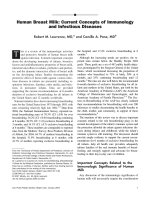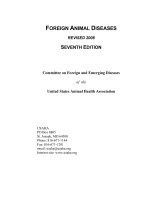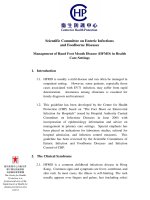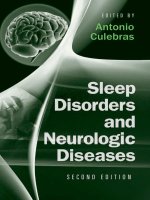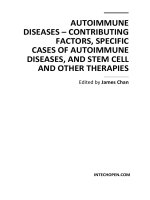autoimmunity and autoimmune diseases
Bạn đang xem bản rút gọn của tài liệu. Xem và tải ngay bản đầy đủ của tài liệu tại đây (1.05 MB, 44 trang )
Autoimmunity and autoimmune
Autoimmunity and autoimmune
diseases
diseases
Autoimmunity
= is an acquired immune reactivity to “self” components
(antigens)
Autoimmune diseases
- occur when autoimmune responses lead to tissue
damage (functional and morphologic changes)
Autoimmunity
Autoimmunity
Original conception -
autoimmunity = unfavourable phenomena
„horror autotoxicus“
Normal process – eliminate self antigens (aggrieved or inappropriate)
autoreactiveT-cells
autoantibodies
Self tolerance
Self tolerance
lack of immune responsiveness to an individual´s own
tissue antigens
3 proposed mechanisms for developing self-tolerance:
a) Clonal deletion
b) Clonal anergy
c) Peripheral suppression
Clonal deletion
Clonal deletion
Positive and negative selection
Positive and negative selection
of T-cells in thymus
of T-cells in thymus
-
loss of clones of T and B
cells during maturation
via apoptosis
-
more operative for B cells
than T cells)
Clonal anergy
Clonal anergy
Nečas et al., 2000
-
irreversible loss of
function of lymphocytes
induced by long-term
enconter of antigens.
T-cell activation requires
to signals. Absence of
second signal (from
antigen presenting cells)
leads to anergy.
Peripheral suppression by T-cells
Peripheral suppression by T-cells
Suppressor T cells (possibly via IL-10) inactivate T helper and
B lymphocytes
Nečas et al., 2000
Causes for loss of self-tolerance
Causes for loss of self-tolerance
Genetic predisposition
Imbalance of suppressor-helper T cell function
Apoptosis
Modification of antigen (via drugs, microorganisms)
Molecular mimicry (infectious agents appear similar to self antigens)
Polyclonal lymphocyte activation (endotoxins cause such activation
independent of specific antigens)
Emergence of sequestered antigen
GENETIC PREDISPOSITION
GENETIC PREDISPOSITION
Association of selected autoimmune diseases with HLA
Association of selected autoimmune diseases with HLA
Diseases HLA Risk*
Ankylosing spondylitis B27 90
Reiter´s syndrom B27 36
SLE DR3 15
Myasthenia gravis DR3 2.5
IDDM DR3/DR4 25
Psoriasis vulgaris DR4 14
Multiple sclerosis DR2 5
Rheumatoid arthritis DR4 4
* Based on comparison of the incidence of the autoimmune disease in patients with
a given HLA type with the incidence of the autoimmune disease in patients
without this HLA type
ROLE OF TH1/TH2 balance
ROLE OF TH1/TH2 balance
Original response is associated with
dominance Th1 or Th2 cytokines
balance Th1 a Th2 ⇒ autoimmune
pathogenesis
Th1 is involved in autoimmunity; TH2 has a
protective effect.
e. g- In gravidity (predominance Th2
cytokines)
Th1 autoim. disease RA improve
Th2 autoim. disease SLE grow
worse
Krejsek et al., 2004
MOLECULAR MIMICRY
MOLECULAR MIMICRY
Role of microbial or viral
antigens
identical or similar as self
cells
⇓
it leads to reaction against
self tissues by same
mechanism which
removed pathogenes
Krejsek et al., 2004
Cross-reacting antibodies play a role in heart damage
Cross-reacting antibodies play a role in heart damage
in rheumatic fever
in rheumatic fever
RELEASE OF SEQUESTERED ANTIGENS
RELEASE OF SEQUESTERED ANTIGENS
The induction of self-tolerance in T cells is thought to result
from exposure of immature thymocytes to self-antigens and
the subsequent clonal deletion of those that are self-
reactive.
Any tissue antigens that are sequestrated from the circulation,
and therefore are not seen by the developing T cells in the
thymus, will not induce self-tolerance. Exposure of mature
T cells to such normally sequestrated antigens at a later
time might result in their activation.
Release of sequestered antigen
A few tissue antigens are known to fall into this
category.
For example:
- following a viral or bacterial infection which
affects the brain-blood-barrier;
-sperm following vasectomy
-eye lens proteins following eye damage
-heart muscle Ags following myocardial infarction
INNAPROPRIATE EXPRESSION OF
INNAPROPRIATE EXPRESSION OF
CLASS II MHC MOLECULES
CLASS II MHC MOLECULES
For example:
The pancreatic beta cells of individuals with IDDM express high levels
of both class I and class II MHC molecules, whereas healthy beta cells
express lower levels of class I and do not express class II at all.
Similarly, thyroid acinar cells from those with Graves´ disease have
been shown to express class II MHC molecules on their membranes.
This inappropriate expression of class II MHC molecules, which are
normally expressed only on antigen-presenting cells, may serve to
sensitize T
H
cells to peptides derived from the beta cells or T
C
cells or
sensitization of T
DTH
cells against self-antigens.
POLYCLONAL LYMPHOCYTE
POLYCLONAL LYMPHOCYTE
ACTIVATION
ACTIVATION
A number of viruses and bacteria can induce nonspecific
polyclonal B-cell activation (G- bacteria, CMV, EBV)
⇓
inducing the proliferation of numerous clones of B cells
that express IgM in the absence of T
H
-ly
If B cells reactive to self-antigens are activated by this
mechanism, auto-antibodies can appear.
IgG and IgM- mediated type II
IgG and IgM- mediated type II
hypersensitivity
hypersensitivity
Antibody (IgM or IgG) directed
mainly to cellular antigens (e. g. on
ERYTROCITE) or surface
autoantigens can cause damage
through
-
opsonization
-
lysis by complement
-
antibody dependent cellular
cytotoxicity
Also called cytotoxic hypersensitivity.
Nečas et al., 2000
Autoimmune hemolytic anemia
Autoimmune hemolytic anemia
Immune-complex mediated type III
Immune-complex mediated type III
hypersensitivity
hypersensitivity
Immune complexes can form to serum
products as well as microbial and
self antigens, either in local sites or
systemically, leading to phagocytic
and complement mediated damage.
Tissue damage is caused mainly by
complement activation and release
of lytic enzymes from neutrophils
-
local damage (Arthus reaction)
-
systemic complexes
⇓
deposition in blood vessels
(vasculitis)
Delayed-type (type IV)
Delayed-type (type IV)
hypersensitivity
hypersensitivity
This occurs from 24 h after contact with
an antigen and is mediated by T
cells together with dendritic cells,
macrophages and cytokines.
Such responses often lead to the
production of granulomas
as an expression of chronic
stimulation of T cells and
macrophages, where there is
persistance of Ag which the immune
system is unable to remove
Type V hypersensitivity
Type V hypersensitivity
It is an example of hypesensitive
reaction against cell receptors:
AutoAbs agains the acetylcholine
receptor found on motor end plates of
muscle. Prevent binding of Ach, and
induce C-mediated degradation of the
receptors
(e. g. myasthenia gravis)
AutoAbs against the TSH-receptor
bind to the receptor and act as TSH
agonists, inducing production of the
thyroid hormones
(e. g. Graves´ disease)
Autoimmune diseases
Autoimmune diseases
Autoimmune diseases form a spectrum
ranging from organ-specific conditions
in which one organ only is affected to
systemic diseases in which the
pathology is diffused throughout the
body. The extremes of this spectrum
result from quite distinct underlying
mechanisms, but there are many
conditions in which there are
components of both organ-specific and
systemic damage.
Reumatoid arthritis (RA) -
Reumatoid arthritis (RA) -
pathogenesis
pathogenesis
Common disease (1% of
population), in general in
women 40-60 years old
It is characterized by
persistent inflammation of
the synovium leading to
varying degrees of joint
destruction.
Genetic predisposition (HLA
DRB) – molecular mimicry
(e. g. EBV)
Krejsek et al., 2004
Reumatoid arthritis - pathogenesis
Reumatoid arthritis - pathogenesis
Krejsek et al., 2004




